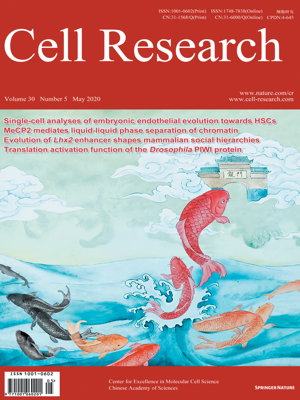
Volume 30, No 5, May 2020
ISSN: 1001-0602
EISSN: 1748-7838 2018
impact factor 17.848*
(Clarivate Analytics, 2019)
Volume 30 Issue 5, May 2020: 436-445 | Open Access
ORIGINAL ARTICLES
Cryo-EM structures of PAC1 receptor reveal ligand binding mechanism
Jia Wang 1, Xianqiang Song2, Dandan Zhang2, Xiaoqing Chen2, Xun Li2, Yaping Sun2, Cui Li2, Yunpeng Song2, Yao Ding2,Ruobing Ren3, Essa Hu Harrington4, Liaoyuan A. Hu 2, Wenge Zhong2, Cen Xu5, Xin Huang 6, Hong-Wei Wang 1 and Yingli Ma 2
1Beijing Advanced Innovation Center for Structural Biology, Tsinghua-Peking Joint Center for Life Sciences, School of Life Sciences, Tsinghua University, Beijing 100084, China; 2Amgen Asia R&D Center, Amgen Research, Bldg. 2, 13th Floor, No. 4560 Jinke Road, Shanghai 201210, China; 3School of Life and Health Sciences, Kobilka Institute of Innovative Drug Discovery, The Chinese University of Hong Kong, Tu H.L. Building (Research Building B) R705, Longxiang Road 2001, Longgang district, Shenzhen 518172 Guangdong, China; 4Hybrid Modality Engineering, Therapeutic Discovery, Amgen Research, One Amgen Center Dr., Thousand Oaks, CA 91320, USA; 5Department of Neuroscience, Amgen Research, One Amgen Center Dr., Thousand Oaks, CA 91320, USA and 6Molecular Engineering, Therapeutic Discovery, Amgen Research, 360 Binney Street, Cambridge, MA 02142, USA
Correspondence: Hong-Wei Wang (hongweiwang@tsinghua.edu.cn) or Yingli Ma (yinglim@amgen.com)These authors contributed equally: Jia Wang, Xianqiang Song
The pituitary adenylate cyclase-activating polypeptide type I receptor (PAC1R) belongs to the secretin receptor family and is widely distributed in the central neural system and peripheral organs. Abnormal activation of the receptor mediates trigeminovascular activation and sensitization, which is highly related to migraine, making PAC1R a potential therapeutic target. Elucidation of PAC1R activation mechanism would benefit discovery of therapeutic drugs for neuronal disorders. PAC1R activity is governed by pituitary adenylate cyclase-activating polypeptide (PACAP), known as a major vasodilator neuropeptide, and maxadilan, a native peptide from the sand fly, which is also capable of activating the receptor with similar potency. These peptide ligands have divergent sequences yet initiate convergent PAC1R activity. It is of interest to understand the mechanism of PAC1R ligand recognition and receptor activity regulation through structural biology. Here we report two near-atomic resolution cryo-EM structures of PAC1R activated by PACAP38 or maxadilan, providing structural insights into two distinct ligand binding modes. The structures illustrate flexibility of the extracellular domain (ECD) for ligands with distinct conformations, where ECD accommodates ligands in different orientations while extracellular loop 1 (ECL1) protrudes to further anchor the ligand bound in the orthosteric site. By structure-guided molecular modeling and mutagenesis, we tested residues in the ligand-binding pockets and identified clusters of residues that are critical for receptor activity. The structures reported here for the first time elucidate the mechanism of specificity and flexibility of ligand recognition and binding for PAC1R, and provide insights toward the design of therapeutic molecules targeting PAC1R.
Cell Research (2006) 16:771-779. doi: 10.1038/sj.cr.7310093; published online 5 Sep 2006
FULL TEXT | PDF
Browse 1041


